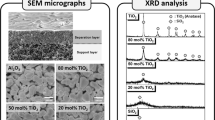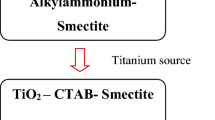Abstract
TiO2-based commercial membranes were coated with SiO2 nanoparticles using solgel dip coating. Membranes were characterized using FTIR, SEM, contact angle and were also tested for the COD removal efficiency. Membrane coating was confirmed from FTIR spectra. SiO2 coating enhanced membranes hydrophilicity.
Access provided by Autonomous University of Puebla. Download conference paper PDF
Similar content being viewed by others
Keywords
1 Introduction
Oil production is still considered as one of the main energy sources in the globe. In the process of oil extraction from its underground formations, the water produced as a by-product is called produced water. This water is usually characterized by its high oil and salt content. Since such water cannot be directly dumped to the environment; it has to be treated first. Membrane technology has shown high potential in treating wastewater with similar properties (Mustafa et al. 2018; Nasiri and Jafari 2016). The research on the use of ceramic membranes in this area has been widely investigated by researchers. This is because of the ceramic membranes’ superior chemical and thermal stability and high mechanical strength (Weschenfelder et al. 2016). They have been tested for their oil removal efficiency, and so far, they have shown promising results in the treatment of oily water as they proved to have high flux, low fouling and good oil removal efficiency. However, different coating and surface modification techniques have been tested on ceramic membranes in order to enhance their properties for the purpose of oil rejection (Puthai et al. 2017), for example, increasing their flux, hydrophilicity, decreasing their pore sizes and enhancing their performance. Therefore, the main objective of this paper was to modify a TiO2 ceramic membrane with SiO2 nanoparticles via solgel dip-coating approach. The modified membrane was used for the treatment of produced water and achieves better rejection of contaminants.
2 Materials and Methods
Commercial ceramic ultrafiltration membranes were used in this research study. The membranes are TiO2-based and have a thickness of 2.5 mm, pore size of 1 kD and a 47 mm diameter. Two of these membranes were coated with SiO2 using the solgel dip-coating method. The SiO2 nanoparticles used have an average diameter of 20 nm and were supplied from EPRUI Nanoparticles & Microspheres Co. Ltd. Membranes, M1 and M2, were dipped in SiO2 solutions of different concentrations: 0.5 and 1 wt%, respectively, for 26 h. The membranes were then left to dry in the oven at 40 °C for 12 h and were calculated after that at 300 °C for 2.5 h and were then left to cool down for 60 min. The membranes were characterized using the Fourier-transform infrared spectroscopy (FTIR) in the range of 4000–400 cm−1 using the attenuated total reflectance technique (ATR) to confirm the presence of SiO2. Moreover, scanning electron microscopy (FEI-Nova-nano-SEM) was also employed to confirm the deposition of silica oxide particles on the membrane surface. Finally, the contact angle test was done using the Kyowa contact angle measuring device, CA-A (Kyowa Interface Science Co., Ltd., Japan) in order to measure the hydrophilicity of the membranes.
3 Results and Discussion
3.1 FTIR
The FTIR was done for the two coated membranes M1, M2 and for an uncoated membrane for comparison. Figure 1 shows the adsorption spectra of the three membranes. It can clearly be seen that the SiO2 coated membrane M2 (with the 1% solution) had the highest peak at 1080 cm−1 which corresponds to the Si–O–Si bond. On the other hand, M1 had a lower peak at the same frequency. This indicates that the different concentration solutions had an effect on the intensity of SiO2 embedded in the membrane surface. A peak at that frequency, however, was not witnessed on the uncoated membrane spectra. This proves that the membrane itself has no peak at that frequency and that those peaks observed for M1 and M2 are due to the SiO2 deposition solely.
3.2 SEM
The Nova-SEM images were used to study the morphology of the three membranes surfaces. Figure 2 shows images of the coated membrane surfaces at 200,000× magnification and the uncoated membrane surface at 400,000× magnification. The white particles seen on the coated membranes surfaces are identified as SiO2 nanoparticles. This was deduced as they show most on membrane M2, less on membrane M1 and are absent on the uncoated membrane.
3.3 Contact Angle
The contact angle test was carried to measure the wettability of the membranes. The results show great enhancement in the hydrophilicity of the coated membranes. Figure 3 shows the water droplets as seen by a high speed camera during the contact angle test when they first hit the membranes surfaces. The contact angle of the uncoated membrane—Fig. (3a)—was 74.7° when it first hit the surface of the membrane, 2700 ms later—when the test was finished—the contact angle was 53.6°. This indicated that the uncoated membrane was fairly hydrophilic. Nevertheless, the hydrophilicity was nearly doubled for the 0.5% coated membrane M1—Fig. (3b)—as the contact angle was 39.7° and took 24 s to completely sink in the membrane. Variously, M2—Fig. (3c)—was super hydrophilic and the water droplet instantly disappeared nearly giving a contact angle of zero.
4 Conclusion
In conclusion, the SiO2 nanoparticles were successfully deposited on the surface of the ceramic membranes as proved with the Si–O–Si bond frequency shown in FTIR spectra. Moreover, the SEM images also indicated the deposition of the SiO2 particles on the coated membranes. In addition, the contact angle measurements showed a significant improvement in the hydrophilicity of the membranes which makes the membranes better oil rejectors. The future work of the authors would be to test the optimum time of the dip coating of the membranes and the calcination time. The testing of the membranes using produced water from the industry will also be done as well to evaluate the membranes’ COD and TOC removal efficiency.
References
Mustafa, G., Wyns, K., Buekenhoudt, A., & Meynen, V. (2018). Antifouling grafting of ceramic membranes validated in a variety of challenging wastewaters. Water Research, 104, 242–253.
Nasiri, M., & Jafari, I. (2016). Produced water from oil-gas plants: A short review on challenges and opportunities. Periodica Polytechnica Chemical Engineering, 61, 73–81.
Puthai, W., Kanezashi, M., Nagasawa, H., & Tsuru, T. (2017). Development and permeation properties of SiO2–ZrO2 nanofiltration membranes with a MWCO of <200. Journal of Membrane Science, 535, 331–341.
Weschenfelder, S., Fonseca, M., Borges, C., & Campos, J. (2016). Application of ceramic membranes for water management in offshore oil production platforms: Process design and economics. Separation and Purification Technology, 171, 214–220.
Author information
Authors and Affiliations
Corresponding author
Editor information
Editors and Affiliations
Rights and permissions
Copyright information
© 2020 Springer Nature Switzerland AG
About this paper
Cite this paper
Marzouk, S.S., Banat, F., Hasan, S.W. (2020). Preparation of TiO2/SiO2 Ceramic Membranes Via Solgel Dip Coating for the Treatment of Produced Wastewater. In: Naddeo, V., Balakrishnan, M., Choo, KH. (eds) Frontiers in Water-Energy-Nexus—Nature-Based Solutions, Advanced Technologies and Best Practices for Environmental Sustainability. Advances in Science, Technology & Innovation. Springer, Cham. https://doi.org/10.1007/978-3-030-13068-8_52
Download citation
DOI: https://doi.org/10.1007/978-3-030-13068-8_52
Published:
Publisher Name: Springer, Cham
Print ISBN: 978-3-030-13067-1
Online ISBN: 978-3-030-13068-8
eBook Packages: Earth and Environmental ScienceEarth and Environmental Science (R0)







